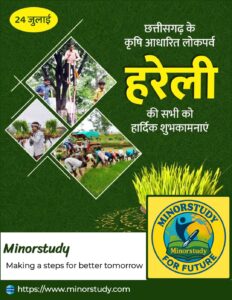🌿 Hareli Festival: A Celebration of Agriculture, Nature, and Life in Rural India
Hareli, derived from the Hindi word “Haryali” (हरियाली), meaning greenery, is a unique rural festival celebrated in the Indian state of Chhattisgarh, along with some parts of Madhya Pradesh and Odisha. While Hariyali Amavasya is a pan-Indian festival rooted in the Sanatan Dharma, Hareli is a more localized, community-centric celebration focused on farming, nature worship, tools, and traditional knowledge.
- 🗓️ When is Hareli Festival in 2025?
- 📖 History and Cultural Origins of Hareli
- 🧭 Timeline: Evolution of Hareli Through the Ages
- 🌱 9 Amazing Reasons Why Hareli Spreads Green Happiness in India
- 1️⃣ Nature-Centric Celebration
- 2️⃣ Worship of Agricultural Tools
- 3️⃣ Symbol of Rural Unity
- 4️⃣ Respect for Cows and Bullocks
- 5️⃣ Traditional Healing Practices
- 6️⃣ Children’s Fun and Learning
- 7️⃣ Promotion of Organic Farming
- 8️⃣ Integration with Sanatan Dharma
- 9️⃣ A Green Alternative to Modern Festivals
- 📌 Observance and Rituals
- 📚 Interesting Facts about Hareli
- 🙋♂️ Frequently Asked Questions (FAQs)
- 🔸 Q1. What is the meaning of Hareli?
- 🔸 Q2. Is Hareli connected to Sanatan Dharma?
- 🔸 Q3. Why is cow dung used in the festival?
- 🔸 Q4. What is the significance of Neem in Hareli?
- 🔸 Q5. Can city dwellers celebrate Hareli?
- 🙏 Hareli Wishes
- 🧘 Importance of Hareli in Modern Life
- 🕉️ Sanatan Dharma Values Reflected in Hareli
- ✅ Conclusion: Why Hareli Matters More Than Ever
Celebrated on the new moon day (Amavasya) of the Shravan month, Hareli symbolizes the beginning of the sowing season, the importance of agricultural tools, and a deep reverence for Mother Earth and nature’s blessings. Let us explore its history, facts, observances, significance, timeline, and its essential role in our daily lives and rural culture.

🗓️ When is Hareli Festival in 2025?
📅 Date: 24 July 2025 (Shravan Amavasya)
🗺️ States Celebrating: Chhattisgarh (major), Madhya Pradesh, Odisha (parts)
🌾 Type of Festival: Agrarian, Eco-Spiritual, Traditional Folk
🔯 Religious Aspect: Worship of Nature, Cows, and Agricultural Implements
📖 History and Cultural Origins of Hareli
🕉️ Ancient Roots
The roots of the Hareli festival can be traced back to tribal and agrarian traditions of central India, particularly among the Gond and Baiga tribes. These communities considered nature, forests, cattle, and tools as sacred.
As per local legends:
The land’s fertility is enhanced when it is respected and honored.
Farmers used to worship their ploughs and bullocks before beginning sowing rituals.
Shravan being the monsoon month, marked new agricultural beginnings.
Over time, these practices got embedded in folk Hinduism, integrating with Sanatan Dharma values, especially Vasudhaiva Kutumbakam (the world is one family).
🧭 Timeline: Evolution of Hareli Through the Ages
| Period | Significant Development |
|---|---|
| Prehistoric/Tribal Era | Worship of earth, animals, and tools among forest dwellers |
| Early Vedic Age | Integration of nature rituals with Vedic chants |
| Medieval Period | Spread of Hareli through rural kingdoms and community fairs |
| British Colonial Time | Suppression of tribal culture, yet Hareli survived locally |
| Modern-Day Chhattisgarh | Hareli is recognized as a state festival and eco-holiday |

🌱 9 Amazing Reasons Why Hareli Spreads Green Happiness in India
1️⃣ Nature-Centric Celebration
Hareli is a festival of trees, plants, and greenery. People clean their surroundings, plant saplings, and decorate homes with fresh leaves.
2️⃣ Worship of Agricultural Tools
Farmers clean and worship their ploughs, sickles, and bullock carts, seeking blessings for a successful crop season.
3️⃣ Symbol of Rural Unity
Hareli fosters community bonding. Villagers come together to sing folk songs, dance, and perform rituals, strengthening social harmony.
4️⃣ Respect for Cows and Bullocks
Cattle are bathed, decorated, and worshipped. Cow dung is used to purify homes, showcasing the holistic cycle of nature.
5️⃣ Traditional Healing Practices
Local Baigas (tribal healers) prepare herbal remedies and tonics from forest herbs. These practices pass down ancestral knowledge.
6️⃣ Children’s Fun and Learning
Children play traditional games like “Gedi” – walking on bamboo stilts – symbolizing balance and environmental awareness.
7️⃣ Promotion of Organic Farming
The use of natural fertilizers, composting, and seed rituals aligns with sustainable agricultural practices.
8️⃣ Integration with Sanatan Dharma
Though tribal at core, Hareli also sees puja to deities like Gauri, Vishwakarma, and Bharat Mata, showing Sanatan inclusivity.
9️⃣ A Green Alternative to Modern Festivals
In an age of plastic and pollution-heavy celebrations, Hareli is a zero-waste, nature-friendly, deeply meaningful festival.
📌 Observance and Rituals
| Activity | Purpose |
|---|---|
| 🛠️ Tool Worship | Gratitude for livelihood and prosperity |
| 🐄 Cow and Bullock Puja | Honor animals that assist in farming |
| 🌿 Neem Tree Worship | Seeking protection from diseases |
| 👨🌾 Plough Sharpening Ritual | Symbolic start to sowing and field preparation |
| 🎭 Folk Games and Music | Celebration and cultural preservation |
| 🪔 Home Purification with Dung | Traditional spiritual and antibacterial practice |
| 🌾 Offering to Mother Earth | Respecting Bhoomi Devi before cultivation begins |
📚 Interesting Facts about Hareli
🎋 “Gedi” competitions among children are the most loved tradition in Chhattisgarh.
🐃 Cattle are not only worshipped but also raced in local fields as part of celebration.
🏆 Chhattisgarh Government officially declared Hareli as a state festival in 2002.
🧴 Herbal tonics made during Hareli are used year-round for fever and digestion.
🌳 Every household plants at least one tree on this day.
🙋♂️ Frequently Asked Questions (FAQs)
🔸 Q1. What is the meaning of Hareli?
“Hareli” comes from “Haryali” meaning greenery, and it celebrates new crops, tools, and life.
🔸 Q2. Is Hareli connected to Sanatan Dharma?
Yes. Though tribal in origin, it has merged with Sanatan practices like puja, Vastu purification, and animal reverence.
🔸 Q3. Why is cow dung used in the festival?
Cow dung is considered sacred and antiseptic in Sanatan Dharma and rural culture. It symbolizes purity and growth.
🔸 Q4. What is the significance of Neem in Hareli?
Neem leaves are tied to doors to ward off insects and evil. It also represents health and healing.
🔸 Q5. Can city dwellers celebrate Hareli?
Absolutely! By planting trees, respecting food and tools, and participating in eco-practices, everyone can honor Hareli’s spirit.

🙏 Hareli Wishes
🌾 “May the fields of your life stay forever green – Happy Hareli!”
🐂 “Let us honor nature, cattle, and crops – Wishing you a prosperous Hareli!”
🛠️ “Celebrate tools, trees, and togetherness – Happy Green Hareli Festival!”
🌳 “Plant a tree, feed a cow, thank the soil – This is the heart of Hareli.”
🧘 Importance of Hareli in Modern Life
| Aspect | Impact |
|---|---|
| 🌍 Environment | Encourages tree plantation and organic lifestyle |
| 🏘️ Society | Reinforces community bonding and cultural continuity |
| 👨👩👦 Family | Children learn about values, tools, and agriculture |
| 🌿 Health | Promotes herbal healing and sustainable living |
| 📿 Spiritual | Reinforces gratitude towards Earth and creation |
🕉️ Sanatan Dharma Values Reflected in Hareli
Dharma: Right conduct in honoring all elements of nature
Ahimsa: Respect and care for animals and soil
Seva: Helping the community and offering to Bhoomi Devi
Simplicity: Celebration without extravagance or pollution
Gratitude: Honoring tools, nature, cattle, and ancestors
✅ Conclusion: Why Hareli Matters More Than Ever
In the age of disconnected urbanization, Hareli reminds us of the roots that nourish us – food, earth, animals, and nature. It brings forward the beauty of simple living, deep spiritual connection with land, and joy of collective gratitude.
This rural festival is more than a day—it’s a life lesson in humility, sustainability, and reverence.
📣 Let us revive the spirit of Hareli in our cities, schools, and homes.
Plant a tree. Respect a tool. Feed a cow. Thank the Earth.
This Shravan, let your heart grow green with Hareli. 🌱







